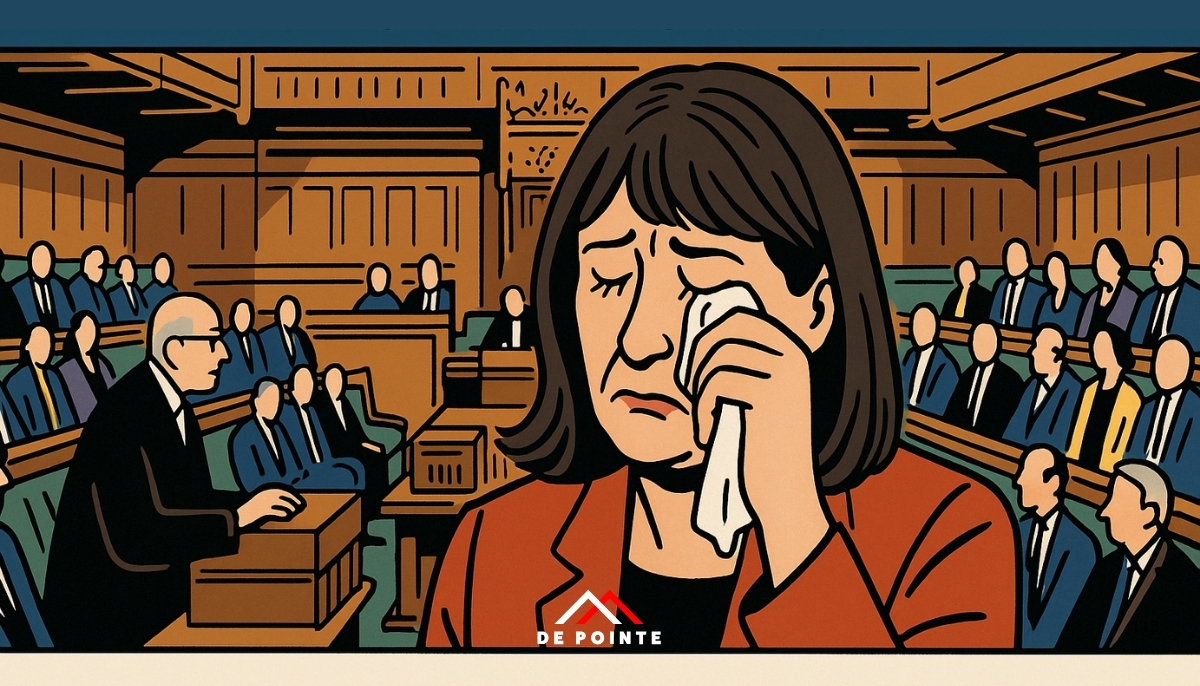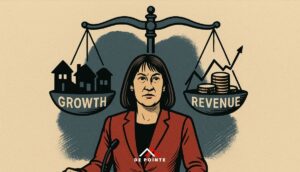Article

The UK economy is navigating a precarious crossroads in 2025. Inflation is easing, yet growth remains tepid. Gilt markets are jittery, and the pound has weakened. Underpinning this financial fragility is a government in crisis; Labour’s internal rebellion over disability benefits has shattered short-term fiscal credibility and rattled investors.
In this article, we unpack the latest developments affecting the UK economic outlook in 2025, examine the impact of government instability, and explore how investors can respond through strategic portfolio positioning.
1. Growth, Inflation and Household Finances: The Data Paints a Mixed Picture
Recent GDP figures showed 0.7% growth in Q1 2025, the fastest among G7 nations. But this apparent strength is deceptive. Growth was driven mainly by public sector activity and net trade, with real household disposable income falling by 1% and consumption flat. Businesses remain cautious, and hiring has slowed significantly since the start of the year.
Inflation, meanwhile, is cooling but not convincingly. The latest CPI print came in at 3.4% in May, marginally down from 3.5% in April. Core inflation remains sticky, and many economists expect an uptick in Q3 due to rising global shipping costs and renewed wage pressure in the service sector.
The labour market is weakening, with wage growth slowing and redundancies rising. This softening will shape the Bank of England’s decision-making through the rest of the year.
2. Government in Disarray: Political Risk Drives Market Volatility
The most immediate threat to investor confidence, however, stems not from economic data but from political dysfunction. The Labour government, barely a year into office, is facing its most severe crisis to date.
Chancellor Rachel Reeves was forced to reverse a controversial disability benefit reform, caving to pressure from over 49 Labour MPs who defied the whip. The proposed reform, which would have cut future welfare spending by £5 billion, was seen as a cornerstone of Labour’s fiscal consolidation plans.
The U-turn spooked financial markets:
- Gilt yields surged, with 10-year UK bond yields rising to 4.7%, their sharpest one-day move since the 2022 Truss-Kwarteng mini-budget crisis.
- Sterling dropped by around 1%, reflecting shaken international confidence.
- The FTSE 100 wobbled amid speculation over the Chancellor’s political future and broader questions about Starmer’s control over his party.
These events suggest rising political risk premiums for UK assets, a crucial consideration for global investors seeking relative safety in developed markets.
3. Fiscal Reality Check: Spending vs Credibility
Beyond short-term market noise lies a deeper structural problem: Britain’s deteriorating fiscal position. The May 2025 budget deficit came in at £12.8 billion, with total government debt rising to nearly 96% of GDP, levels unseen since the post-World War II period.
The Spending Review 2025 promised modest investment in green infrastructure, housing, and education, but fiscal experts warn it breaches Labour’s own fiscal rules. The Office for Budget Responsibility and Resolution Foundation project a deficit of 1.6% of GDP by 2029/30, even under optimistic scenarios.
If the government continues to fold under internal pressure and populist sentiment, serious questions will arise about Britain’s ability to fund public services without significant tax rises or spending cuts, both of which carry political and economic risks.
4. What’s Next for Monetary Policy?
The Bank of England has held rates at 4.25%, but several members of the Monetary Policy Committee (MPC) have recently struck a more dovish tone. Alan Taylor, one of the more hawkish voices, warned in early July that the path to a “soft landing” is at risk, and that five rate cuts may now be needed in 2025 to counteract weakening demand.
Markets are currently pricing in two to three cuts by year-end, with more expected in 2026. However, any resurgence in inflation or another round of political uncertainty could delay the Bank’s response or limit the scope of loosening.
5. Investment Implications: What Should Investors Do?
With political turmoil, fiscal fragility, and monetary uncertainty colliding, how should investors position themselves?
a) Diversify into non-correlated assets
This is a textbook environment for alternative investments, art, gold, collectables, and other tangible assets that hedge against market volatility and policy missteps.
b) Limit long-duration exposure
The gilt curve is vulnerable. Until political leadership stabilises and inflation falls convincingly below 2%, long-dated bonds are likely to remain volatile.
c) Hedge currency exposure
Sterling volatility is back. Investors with international portfolios or UK earnings should consider active currency hedging strategies to mitigate risk.
d) Watch for tactical opportunities
Sectors such as infrastructure, renewables, and inflation-linked securities may benefit from short-term fiscal policy changes, particularly if Labour shifts back to a stimulus-oriented approach.
Don’t Mistake Calm Markets for Stability
While the UK economy appears to be “muddling through,” the situation beneath the surface is more fragile than headline numbers suggest. Political credibility is the cornerstone of economic stability. Without it, investor confidence can unravel fast, as we saw with the Truss government in 2022 and again this week with Reeves’ policy reversal.
For investors, the UK’s economic outlook in 2025 should be approached with caution, but also with an eye to opportunity. Periods of dislocation often offer value for those prepared with the right strategies.
At De Pointe Research, we advocate diversified exposure across asset classes and geographies, anchored by tangible, non-correlated alternatives that preserve wealth even as policymakers lose their footing.
Looking to hedge your portfolio against UK uncertainty?
Contact us today to access our research into fine art, gold, and inflation-resistant investments.





